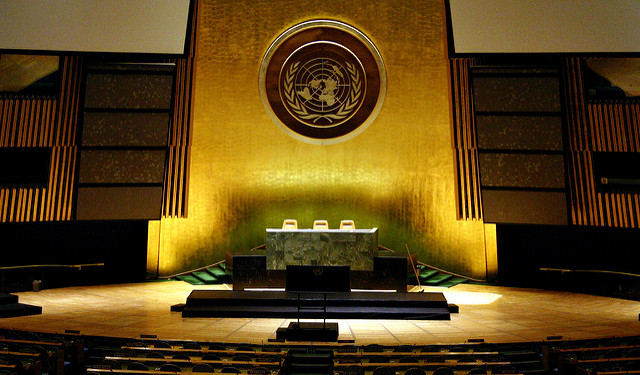
Welcome back to ASPI suggests, where we kick off this week’s reading, listening and viewing suggestions with the confirmation of eight candidates vying for the top job at the United Nations—half of whom are women. From 12–14 April, the candidates had two hours to state their case to the General Assembly (and the rest of the world as each session was broadcast live). The Australian has a short piece on the specifics of what’s likely to be the world’s most challenging job interview, while TIME takes a more in-depth look at each candidate’s background and platform. Watch this space for more on the Secretary-General race—one of the good burghers of Australia, Kevin Rudd, is yet to announce his highly-anticipated candidacy…
Also on the UN, we thoroughly recommend checking out the brand new report that came out of last October’s Challenges Annual Forum, written by ASPI’s Lisa Sharland. The report discusses findings from a number of recent UN reviews on peace operations, peacebuilding, women, peace and security and the UN’s sustainable development goals.
The Strategy Bridge, now a well-established forum for military-related chat, recently unfolded a sharp series on the topic of military leadership in the 21st century. The editors roamed far-and-wide to pull together a collection of 15 pieces from a range of well-versed professionals both inside and outside of the US military. Insights and ideas abound.
As the Permanent Court of Arbitration prepares to hand down its decision in the landmark Philippines v China case, CNAS researchers Mira Rapp-Hooper and Harry Krejsa have released a report exploring a range of potential rulings and the impact that each might have on China, ASEAN and the US, as well as on future arbitration. The research concludes:
‘The Tribunal’s ruling will likely usher in a period of heightened regional tensions as the relevant players jockey to maximize the political mileage they can derive from the decision. With any hope, however, all will place this much-awaited ruling in its historical and geopolitical context, and acknowledge that it is an early step toward longer-term clarity in the South China Sea that may not yield immediate tangible changes. Indeed, the ruling’s greatest political value will come if it sets meaningful precedent and is embraced by the region as legitimate and useful. This may, in turn, help to catalyze future cases that reduce the vexing disputes in the South China Sea.’
If you’re in need of a slightly larger dose of maritime security info than usual, be sure to check out the National Bureau of Asian Research and the Sasakawa Peace Foundation USA’s brand spanking new collaboration, the Maritime Awareness Project. MAP aims to deliver expert analysis and news on maritime security issues in the Asia–Pacific and to help observers of the South and East China seas to better understand each dispute.
When considering the most likely hotspot for maritime conflict, few would pick the Baltic Sea. However, after several Russian Sukhoi Su-24 aircraft made some startlingly low passes over the USS Donald Cook earlier this week, many (including the ship’s crew) have been left with their mouths agape. The Pentagon has slammed the manoeuvres, which saw the grounding of the ship’s helicopter operations while a series of videos shot by crew show the dangerous proximity of the Sukhois to Donald Cook. Foreign Policy also offers some complementary analysis on the lack of subtlety in Russian approaches to international relations.
While we’re on the verge of declaring a moratorium on all things Trump here at The Strategist HQ, there’s almost no escaping The Donald’s spectre when it comes to the US–Mexico border fence. Happily, The Atlantic has a safe space for all of us, with their photo essay on an art project by Ana Teresa Fernández. The Mexican-born American artist led a team to paint three large sections of the fence sky blue, effectively ‘removing’ parts of the imposing barrier. Neat idea.
Podcasts
Intel wonks should definitely check out the latest offering (51 mins) from the International Spy Museum’s podcast series, Spycast. This week’s episode includes an interview with former CIA IO and daily intelligence briefer David Priess on the history of the President’s Daily Brief, the most tightly managed intelligence briefing in the world—a subject which he recently published a book on.
CSIS’s CogitAsia podcast series has an excellent listen for Southeast Asia watchers—an in-depth look at the rise of Aung San Suu Kyi, the leader of Myanmar’s National League of Democracy, and the internal and external challenges that her party must face after its 1 April inauguration. Listen here (32 mins).
Videos
CSIS’ Zbigniew Brzezinski Annual Prize acknowledges the ‘importance of geostrategic thinking with a transcending moral purpose’. The inaugural recipient was Robert Gates, US Secretary of Defense from 2006 to 2011. In delivering some short remarks before a wide-ranging Q&A (1 hour), Gate’s offered his realist view of American role in promoting democracy and human rights abroad, the blending of ‘tough-minded realism with high-minded idealism’.
Events
Canberra: As part of their Power, Ethics & World Order Seminar Series, the ANU’s Department of International Relations will next week host Simon Adams, executive director of the Global Centre for the Responsibility to Protect, who will take the temperature of the R2P initiative in the UN Security Council. Register online.
Sydney: The University of Sydney’s Southeast Asia Centre will be hosting a fascinating conversation with Jim Hoesterey of Emory University on Indonesia’s promotion of ‘moderate Islam’ in an effort to counter domestic terrorism and Daesh’s influence. Mark your diaries for 20 April and register here.

